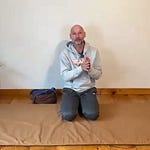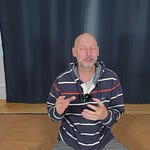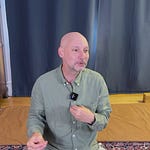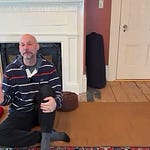Welcome. This is a space for reflection, meditation, and the embodied nectar of Yin Yoga. If you’re new here, I invite you to check out Begin Here for a quick introduction and a few free practices to give you a feel for what this publication offers each week.
This week’s post is especially for those who may have no interest in yoga—or who’ve felt left out by what yoga seems to be. The practice I share above is one I’ve been returning to often, especially in times of transition and overwhelm. It’s simple, grounding, and might just be the most human kind of yoga there is.
If you’re like most people, the word yoga might conjure up a predictable set of images:
A roomful of hyper-flexible people flowing through graceful poses.
Designer leggings and curated mindfulness.
That one friend who won’t stop talking about their handstand progress.
And if you’re like a lot of other people, maybe yoga has always seemed a bit… off-putting. Maybe you’ve felt too stiff, too skeptical, or just too allergic to anything that feels like performative wellness.
If that’s you, then Yin Yoga is the antidote—and quite possibly, the only kind of yoga that might actually make sense to you.
What Is Yin Yoga? (And Why Should You Care?)
Yin Yoga is floor-based, non-performative, and unapologetically slow. You don’t need to “flow” through anything. You don’t need to balance on your hands. You don’t need to look a certain way in a posture. And if you’ve been avoiding yoga because you think you’re not flexible, congratulations—you are precisely who this practice was made for.
Here’s how it works:
You settle into a simple, accessible shape. (Think: seated, lying down, no circus tricks.)
You stay there for a few minutes, letting gravity and time do the work.
You breathe. You notice. And in the process, something shifts—not just in the body, but in the mind.
It’s yoga for real people with real tension and real stress. It’s a practice of unwinding—of letting go of excess effort rather than adding more.
Why Does This Matter?
Because most of us are clenched, braced, and gripping—physically, mentally, emotionally. We hold tension in ways we don’t even realize, and over time, this tension becomes the background noise of our existence. It shapes our posture, our breathing, our moods.
And, critically, it shapes our ability to respond to life.
Release tension in the body, and suddenly, you’re not as reactive.
Create space in your joints, and suddenly, your thoughts have more space too.
Learn to sit with stillness, and suddenly, the nervous system recalibrates—shifting from the high-alert state of modern stress to something more grounded, clear, and centered.
Yin Yoga isn’t just about stretching. It’s about changing the way we relate to tension—inside and out.
But What About the Science?
The benefits of Yin Yoga go well beyond stress relief:
🌀 Fascia & Connective Tissue Health – Yin Yoga applies gentle, sustained pressure to the body’s fascia (the web of connective tissue that surrounds muscles, joints, and organs), improving fascial hydration, organization and integrity.
Listen to this episode with a 7-day free trial
Subscribe to From Scratch with Josh Summers to listen to this post and get 7 days of free access to the full post archives.












